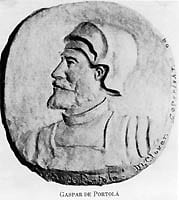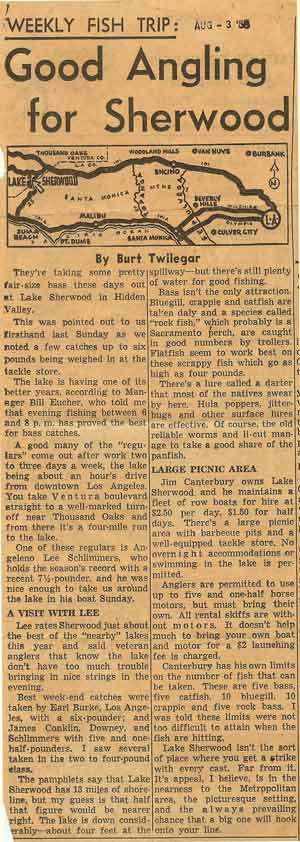(original article appeared in the “News Chronicle” in January of 1985)
by David Harpster
photos by Roger Hardy
LAKE SHERWOOD has been good to Jack Speirs. ~ So Jack Speirs is repaying the favor.
The longtime lake resident, who fought hard to rescue the former movie star hideaway from intensive urban development, says he owes his good fortune to the once picturesque lake.
“What I have here, and all I’ve done, is all because of the people I met and friends I’ve made at Lake Sherwood,”
the 68-year-old writer said.

Lake Sherwood’s Hero
“So I figured owed a debt to the lake, and I damn well pay my bills.”
Speirs, who discovered the lake by accident while trying to drive to Port Hueneme in the early 1940s, was a high school dropout with his outdoor sights set on being a Hollywood writer when he and his wife, Hazel, first set eyes on it.
“It looked just like a Southern lake, a private heaven,”
Addicted to its beauty and splendid bass fishing, Speirs spent as much time as he could at, acquiring quite a reputation as a fisherman among Clark Gable, Gary Cooper and other celebrities and writers who hung out there when the area was a favorite spot for location shooting by movie crews.
“Then it occurred to me that I was wasting my time knocking at the back door of the studios,”
he recalled and jumped at an offer to manage the the lake.
While performing his managerial duties, Speirs worked occasionally as a stuntman and “met a “whole bunch of guys” employed by the Walt Disney studios, as well as a variety of radio and baseball film writers and actors.
Speirs, lacking a formal education,
“I dangle participles and fish worms with equal joy”
was at first reluctant to broach the topic of breaking into the writing business with his fishing buddies.
“But then one of them told me that if you can communicate clearly and cleanly, you’re grammar’s going to be OK,”
After writing a story outline and script for ‘a radio detective show, for which he was paid $400, Speirs’ career took off. He later penned and produced more than 60 screen and television films for Disney, including “Vanishing Prairie” and “Nature’s Half-Acre.”
He also wrote all of Walt Disney’s personal TV material from 1952 to 1966, and scribed more than 175 dramas and mysteries for radio.
In addition, he authored nearly 500 articles for outdoor and sporting magazines.
His paucity of schooling. – he attended Polk Creek Elementary School in West Virginia and spent exactly one week enrolled in high school – hasn’t hindered him a bit, Speirs said.
“That’s as far as I got. I didn’t want school to interfere with my education,”
“If I had to do it all over again I’d leave sooner.”
After “bumming around the country,” doing odd jobs, Speirs met his wife-to-be, Hazel, in California m 1940, and married her in 1941.
In 1949, they gave up managing the lake and my bought a lakefront home, enjoying an enviable life until 1962, when Dayton Realty Co. purchased the lake and riled everyone up with its development plans.
“They were so high-handed…”
“They beat everyone over the head with an invisible baseball bat. What they were proposing was a total violation of Ventura County ordinances.”
What ensued was a years-long struggle against Dayton, marked by the draining of the lake in late 1983 and culminated by its recent purchase by multimillionaire David H. Murdock.

Jack Speirs fishing on Lake Sherwood
Speirs helped launch an extensive homeowners campaign-against Dayton’s plans, but he refuses to take any bows for the ultimate success.
Instead, he credits the Ventura County Board of Supervisors, former Gov. Edmund G. Brown Jr. and other government officials with thwarting Dayton’s proposal to build 1,395 lakefront homes and related commercial facilities.
Speirs also praises financier Mr. David H. Murdock for acquiring the lake from Dayton, and instead proposing a scaled-down development plan.
Sipping a beer and reflecting on the long battle to save the lake, Speirs said in a recent interview that he was just one of several vocal opponents of Dayton’s plans.
Fellow homeowners Yvonne Emerson and the late Lillian Borgeson were also instrumental in fighting the Beverly Hills realty firm, and many other lake residents also participated in the foray, he said.
“I had a little help from a lot of people and a lot of help from a little people,”
he explained.
“All we did – and all I did – was to support the county officials and ordinances and keep the issue alive,” he continued. “We didn’t give up and let Dayton have its way. The only way you can lose is if you quit.
“That’s all I did. I didn’t quit,”
Speirs also extolled his wife’s support and understanding over the years.
The 150-acre lake is now dry, awaiting formal county approval of Murdock’s plans first to clean up the lake, then to refill it and develop the surrounding land. Speirs called Murdock a “sensible environmentalist” and believes the wealthy landowner will succeed in cleaning up weeded lakebed and getting rid of unsightly docks.
“He has good taste,”
“That’s a rare quality. He has an unlimited ability to think on a great scale.”
Is he relieved that an apparent solutions to the lake is at hand?
“Relieved? ” Damned right, I’m relieved,” he replied.
He said he now wants to focus his energy on traveling to Nashville, Tenn to sing country music.
“That’s what I started out doing back in West Virginia,” he recalled. “You don’t have to be good. Just loud and willing.”
Download original article here












